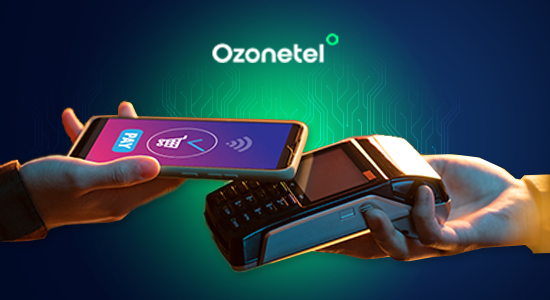- Resources
- What Is Conversational Commerce? Definition and Guide
What Is Conversational Commerce? Definition and Guide

Key takeaways
- Conversational commerce uses chat, voice, and messaging to simplify buying decisions and boost conversions.
- It delivers real-time, personalized interactions that reduce friction and improve customer satisfaction.
- AI tools like voice bots, chatbots, and agent assist enhance efficiency and enable 24/7 engagement.
- Key use cases include pre-sales support, cart recovery, order tracking, and loyalty programs.
- Platforms like Ozonetel unify chat and voice channels to turn every customer conversation into a sales opportunity.
Conversational commerce is the practice of using real-time messaging, voice, and chat-based interactions to guide customers through the buying journey.
Traditional eCommerce focused on website clicks, search bars, and static checkouts. But buying behavior has changed. Shoppers now expect quick responses, real-time assistance, and the ability to ask questions before they buy. They don’t want to scroll through product pages—they want guidance.
This is where conversational commerce comes in. It sits at the intersection of messaging and eCommerce, allowing customers to browse, ask, compare, and buy through a single conversation.
In this article, we will explore:
- 1.What is Conversational Commerce?
- 2.How Does Conversational Commerce Work?
- 3.Core Components & Technologies of Conversational Commerce
- 4.Key Benefits of Conversational Commerce
- 5.Use Cases of Conversational Commerce
- 6.Best Practices: Steps to Implement Conversational Commerce
- 7.Future Trends in Conversational Commerce
- 8.Powering Conversational Commerce with Ozonetel
What is Employee Experience?
Employee Experience (EX) is the overall perception employees have of their journey within an organization. It encompasses every interaction and touchpoint, from recruitment and onboarding to daily responsibilities, support systems, and eventual offboarding.
What is Conversational Commerce?
Conversational commerce is the use of messaging apps, chatbots, and voice assistants to facilitate buying decisions. It allows customers to ask questions, compare products, and make purchases within a single conversation, without switching platforms.
For eCommerce brands, it reduces drop-offs, simplifies decision-making, and personalizes the buying experience. Instead of browsing through pages, customers get instant answers and support, leading to faster conversions and higher satisfaction. It’s where convenience meets conversion.
How Does Conversational Commerce Work?
Conversational commerce works by enabling real-time, two-way interactions between brands and customers through digital touchpoints like WhatsApp, chatbots, voice calls, or live chat. These conversations guide users through the entire buying journey—from product discovery to final checkout—without needing to navigate a website or app.
Here’s how it typically flows:
1.Product Discovery: Customers ask questions via WhatsApp or chat widgets (“Show me vegan snacks under Rs 100”). AI bots or human agents instantly share personalized suggestions.
2.Engagement & Clarification: Shoppers can compare features, check availability, or ask follow-ups (“Is this available in Mumbai?” “What’s the expiry date?”). Responses are contextual and quick.
3.Decision Support: The interaction may involve sending videos, catalogues, reviews, or real-time offers, helping customers make confident decisions. Bots can highlight promotions or cross-sell items.
4.Transaction Execution: Once the customer is ready, a payment link is shared within the same chat. No redirects, no forms. Everything happens inside the conversation.
5.Post-Purchase Support: Order confirmations, delivery updates, and return requests can be handled within the same thread. For brands, this builds continuity and trust.
Core Components & Technologies of Conversational Commerce
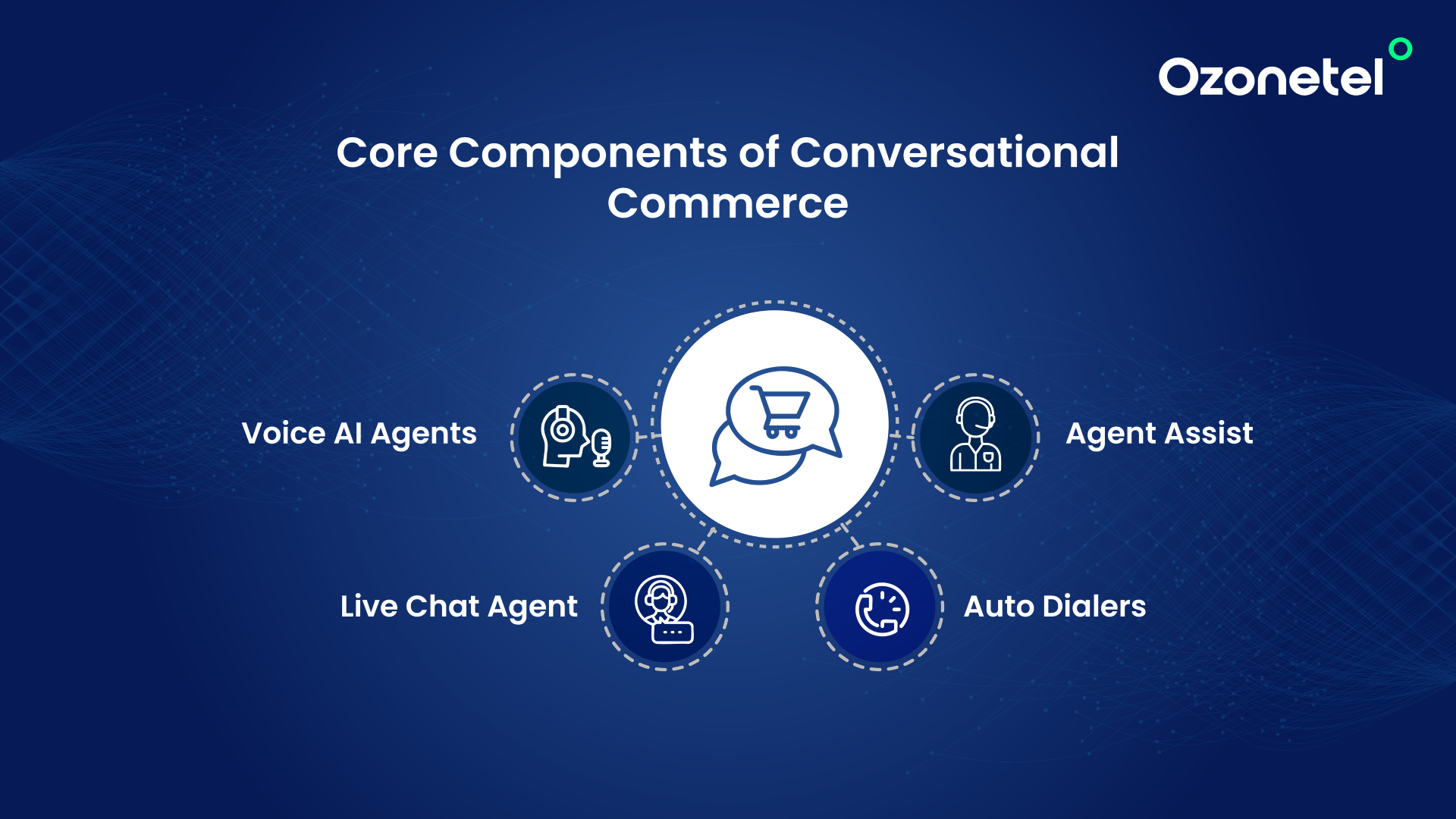
Conversational commerce is a coordinated system of tools that work together to engage customers, answer questions in real time, and convert intent into revenue. Below are the core components and technologies that make this possible:
CXi Switch
CXi Switchis a first-of-its-kind internet communication widget that powers instant voice and digital conversations across all customer touchpoints – serving as a seamless alternative to traditional telecom channels.
Key advantages of CXi Switch:
- No reliance on telecom providers—you fully own your communications
- Easy integration for any website, enabling instant connectivity
- Deploy voice bots or connect to any CCaaS platform behind the widget
- Works with your existing CCaaS provider—no platform lock-in
- Supports DTMF tones, allowing smooth IVR migration
In short, CXi Switch is your internet-first gateway to smarter, telecom-free customer conversations.
Voice AI Agents
Voice AI agents automate large volumes of inbound and outbound calls using natural language understanding. They can handle tasks like product recommendations, order confirmations, payment reminders, and more—all without human intervention.
These AI agents are trained on customer intent, tone, and language patterns, making them suitable for both transactional and support use cases. They free up human agents for higher-value conversations and ensure round-the-clock availability, even during peak hours.
Live Chat Agent
Live chat agents step in when automation needs human judgment. Whether it’s resolving a complex query, guiding the buyer through a checkout step, or offering personalized recommendations, chat agents are central to delivering a human touch in commerce.
Agent Assist
Agent Assist is a real-time agent support system that provides on-screen guidance during conversations. As agents speak or chat with customers, Agent Assist surfaces relevant knowledge base articles, product FAQs, sentiment cues, and even upsell prompts.
This improves both speed and accuracy, especially helpful for new agents or high-stakes sales scenarios. In a commerce setup, Assist can dynamically suggest discounts, bundle offers, or cross-sell options based on customer intent, helping boost conversion and order value.
Auto Dialers
Auto dialers automate outreach to leads—be it abandoned carts, interest forms, or campaign follow-ups. With tight CRM integration, they can prioritize high-intent contacts and initiate calls at optimal times.
Agents only connect when a lead answers, improving efficiency. In conversational commerce, auto dialers are powerful for re-engagement—nudging prospects toward purchase, reminding them about items in cart, or pushing time-sensitive deals—all while maintaining a human conversation.
Key Benefits of Conversational Commerce
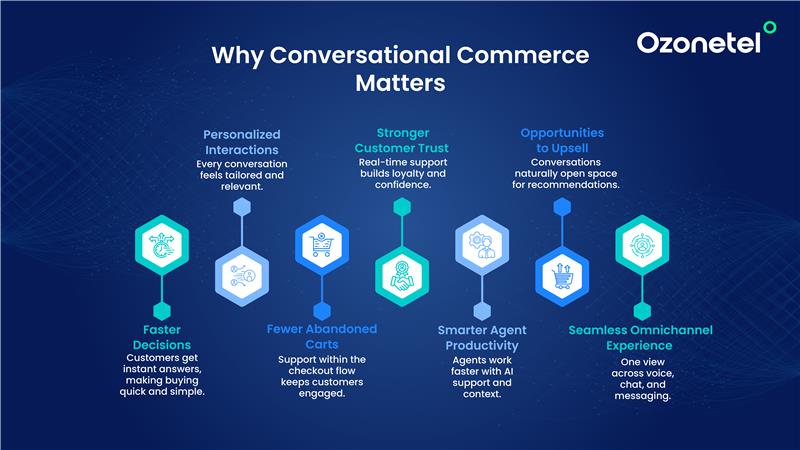
Conversational commerce is not just a trend—it’s a smarter, faster way to sell and support. By enabling real-time conversations across messaging and voice channels, it helps brands improve efficiency, reduce friction, and convert intent into revenue. Here are the key benefits:
- Faster Purchase Decisions: Customers don’t have to browse endlessly or wait for callbacks. With real-time product suggestions, availability checks, and instant payment links, decisions happen in a single conversation, drastically shortening the buying cycle.
- Higher Conversion Rates: Engaging with customers when they’re actively looking or have questions increases the chance of closing a sale. Personalized responses, relevant recommendations, and immediate support remove hesitation and drive more checkouts.
- Reduced Cart Abandonment: Customers often abandon carts due to confusion, missing information, or a lack of support. Conversational touchpoints like WhatsApp nudges or live chat during checkout help address objections instantly, recovering lost revenue.
- Better CX and Retention: Conversations create trust. Customers feel heard, get faster resolutions, and are more likely to return. This personalized experience boosts satisfaction scores, reduces complaints, and increases loyalty.
- Improved Agent Efficiency: Agents can handle multiple conversations at once, switch between chat and call without losing context, and rely on Assist tools for faster responses. This leads to better workload distribution and higher productivity.
- More Opportunities for Upsell & Cross-Sell: Conversational flows make it easy to recommend complementary products or offer time-bound deals—based on the customer’s intent and behavior—resulting in higher average order value.
- Unified View Across Channels: With platforms like Ozonetel, all conversations—whether voice or text—are stitched into one system. This gives teams full context, better reporting, and consistent follow-ups without duplication or data gaps.
Use Cases of Conversational Commerce
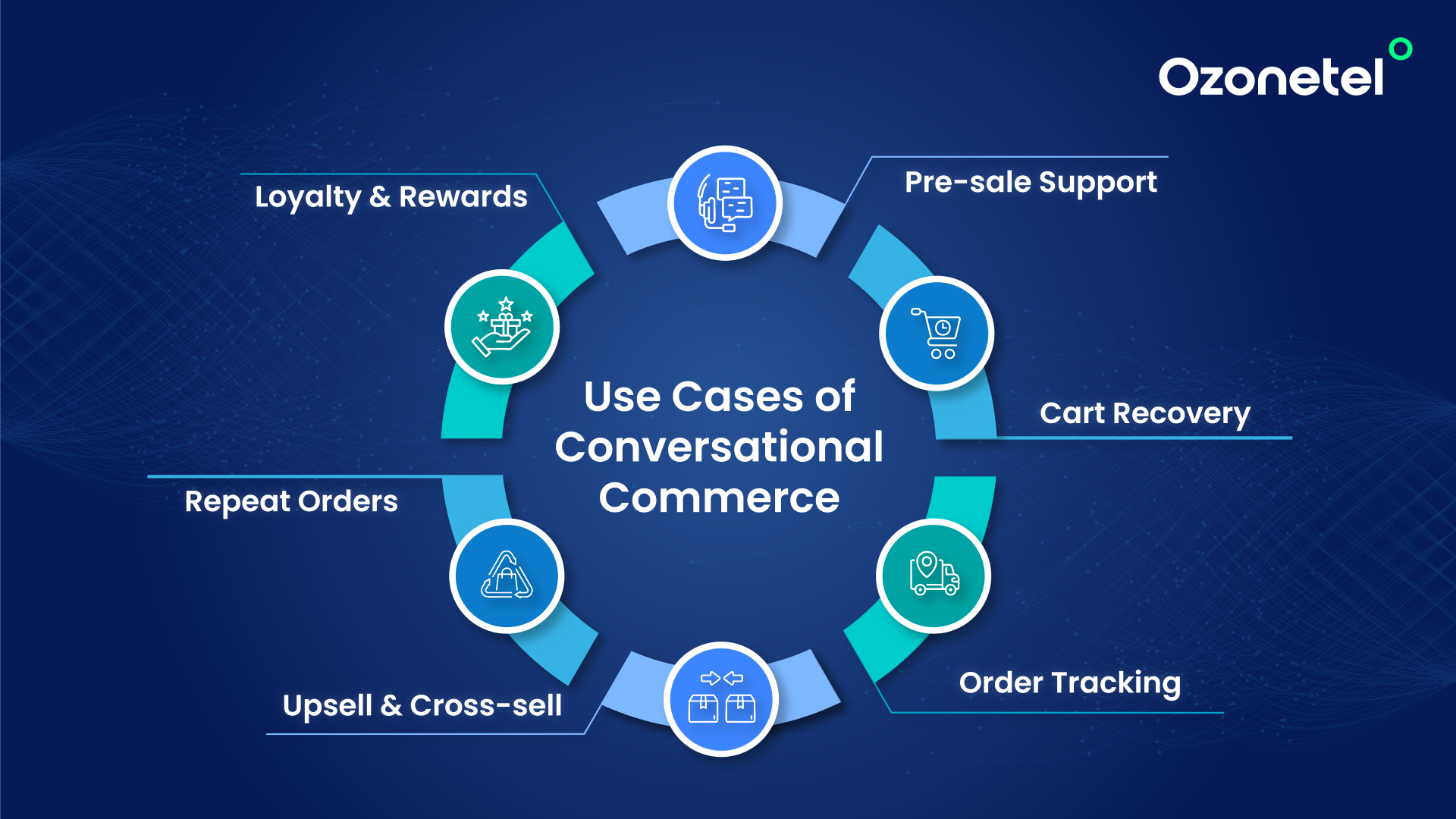
Conversational commerce is about driving action at every stage of the digital customer journey. Here’s a breakdown of the most valuable use cases, along with how global and Indian brands are using them to deliver outcomes:
Pre-sale Support
Helping customers make purchase decisions in real time is one of the strongest use cases. Through chat or voice, brands can guide buyers through comparisons, product details, and offer eligibility. For example, Tata 1mg uses this to support users looking for diagnostic tests or prescription medicines, offering on-the-spot information through chat and call. This clarity at the decision stage helped them boost conversions by 5% and reduce friction across high-involvement purchases
Cart Recovery
Reaching out to users who abandon carts—especially with timely nudges—can bring significant ROI. WhatsApp reminders, automated voice calls, or even chatbot follow-ups help recover lost sales. Wakefit applies this with auto dialers and IVR-based workflows to follow up on incomplete transactions. With smart call routing and reduced wait times, they achieved a 5X improvement in FCR and lowered their overall resolution time by 25%
Order Tracking
Customers want real-time visibility after they purchase. Giving updates via WhatsApp or voice helps reduce anxiety and avoid WISMO (“Where is my order?”) queries. For example, Wakefit solved this by implementing a smart IVR-based delivery confirmation system, allowing customers to choose delivery time slots. This reduced failed deliveries by 10% while saving costs on reverse logistics and support effort.
Upsell & Cross-sell
Conversational touchpoints are perfect moments to recommend complementary products or upgrades. Timing and context make a huge difference. Tata 1mg, for instance, uses customer history and campaign data to pitch related products like wellness packages or health subscriptions during support or order confirmation calls. This context-driven engagement played a role in driving 15% overall business growth.
Repeat Orders
For recurring-use products, simplifying reordering boosts retention. WhatsApp re-order flows or voice bots allow customers to reorder in seconds, without visiting the site or app again. Global brands like Domino’s have built entire repeat ordering journeys on voice assistants and chat. It’s convenience-driven retention, automated at scale.
Loyalty & Rewards
Customers often forget to check loyalty points or miss out on member benefits. By proactively communicating offers or point balances through chat, brands drive more program engagement. While H&M uses chatbot nudges to keep loyalty top-of-mind, Wakefit uses voice campaigns post-delivery to educate users on product usage, building trust and reducing returns by 5%.
Best Practices: Steps to Implement Conversational Commerce
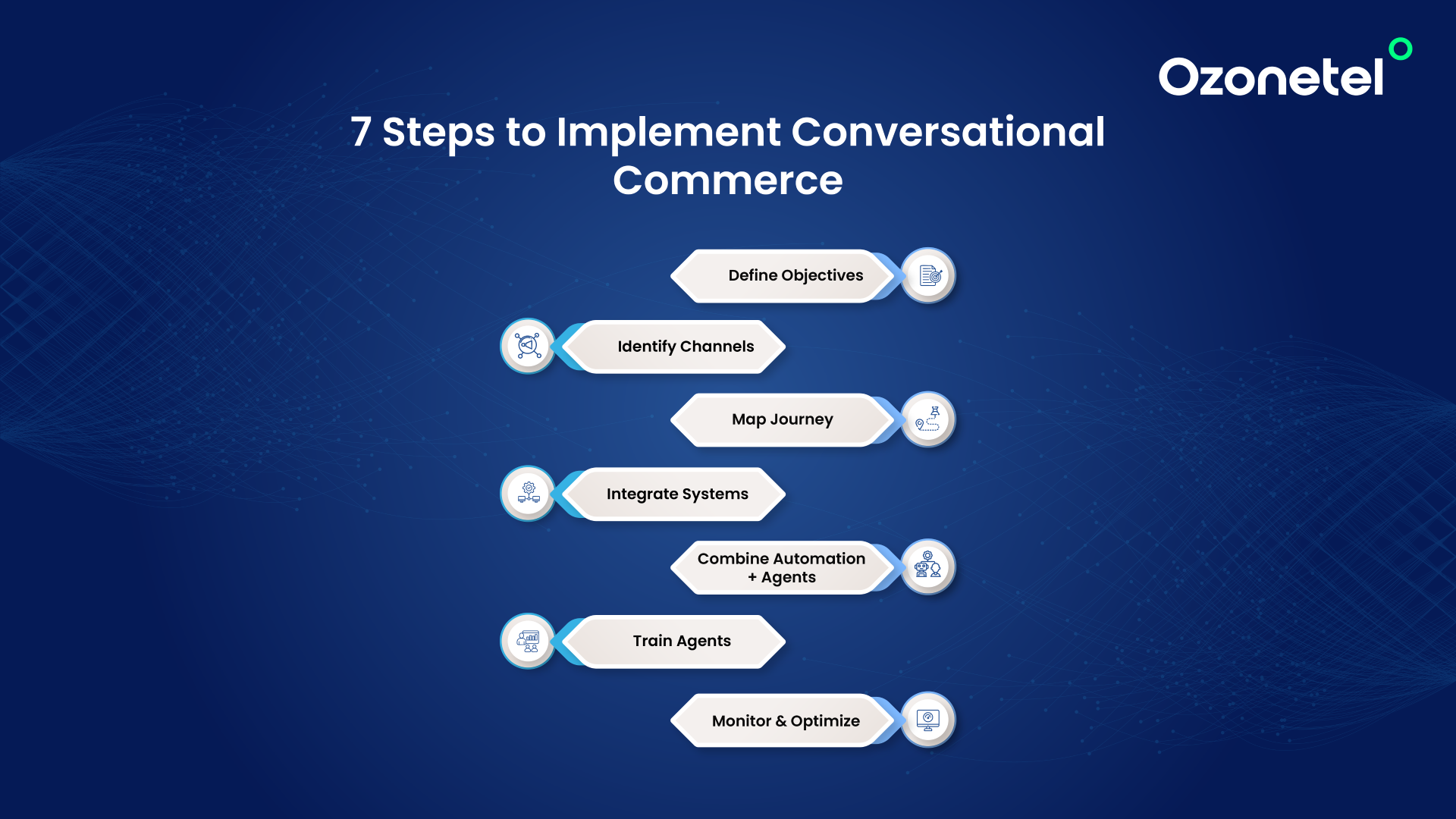
Rolling out conversational commerce isn’t just about having an ecommerce call center software, adding a chatbot or launching a WhatsApp number. It requires thoughtful planning, tech alignment, and customer-first design. Here’s a step-by-step approach to do it right:
1. Define Clear Objectives
Start with clarity. Are you aiming to reduce cart abandonment, improve repeat orders, increase conversions, or support post-sales service? Set specific goals linked to your funnel—this helps shape workflows, content, and channel selection.
2. Identify the Right Channels
Choose the platforms your customers already use—WhatsApp, Instagram, website chat, voice, or all of the above. Use historical engagement data to prioritize. For example, retail and D2C brands often see higher conversions via WhatsApp, while high-ticket or complex purchases work better with voice and chat combined.
3. Map the Customer Journey
Design conversation flows around actual customer actions: browsing, adding to cart, dropping off, or requesting support. For each stage, build responses, nudges, and actions that are relevant and timely. Don’t over-automate—know where human handover is necessary.
4. Integrate with Backend Systems
Ensure your conversational layer connects with your CRM, order management, payment gateway, and marketing stack. This enables personalized responses, faster resolutions, and real-time order or delivery updates—all without customers repeating themselves.
5. Combine Automation with Live Agent Support
Start with AI agents for FAQs, product discovery, and transactional tasks. But always give users the option to talk to a human for complex queries. Platforms like Ozonetel allow seamless switching between bots and agents, even mid-conversation.
6. Train Agents and Set Workflows
Live agents need support tools like Assist, access to past interactions, and real-time prompts. Align their KPIs with conversation outcomes—conversions, resolutions, CSAT—rather than just call volume.
7. Monitor, Learn, and Optimize
Track metrics like FCR, cart recovery rate, AOV, drop-off points, and sentiment. Use VoC analytics to detect objections, failed journeys, or friction areas—and update your flows regularly. Conversational commerce should evolve with customer expectations.
To amplify these strategies, align your efforts with conversational marketing— it’s how leading brands build ongoing, high-converting relationships.”
Future Trends in Conversational Commerce
Conversational commerce is evolving fast—from simple chatbots to intelligent, revenue-driving systems. As customer behavior and tech stacks mature, here are the key trends shaping their next phase:
Conversational commerce is shifting from transactional chatbots to full-fledged engagement engines that blend AI, automation, and personalization. What’s coming next isn’t just more tech—it’s smarter, real-time, and deeply embedded commerce. Here’s what to expect:
1. Converging Voice and Messaging in Real Time
The future of customer interaction isn’t choosing between voice or chat—it’s using both, at the same time. Customers may start with a WhatsApp message, shift to a phone call, and continue the conversation without repeating context.
Platforms like Ozonetel’s CXi Switch already support simultaneous engagement across channels—where agents can speak to the customer while sharing payment links, product info, or documents via chat. This drastically reduces friction, improves conversions, and shortens sales cycles.
2. Generative AI for Intent-Based Conversations
GenAI is redefining how brands use automation. Instead of bots that follow rigid flows, we’ll see AI that understands open-ended questions, tailors replies based on customer profiles, and adapts tone and content in real time. These bots won’t just answer queries—they’ll navigate the buying journey, offer real-time comparisons, surface discounts based on behavior, and close sales—all through natural dialogue.
3. Embedded Commerce Inside Chat Apps
WhatsApp, Instagram DMs, and Google Business Messages will become full-fledged storefronts. Users will discover, inquire, pay, and track—all within a chat window, no app download or website visit required.
This shift will reduce abandonment, simplify mobile commerce, and create a new high-intent sales channel. Expect more integrations with UPI, digital wallets, and embedded checkouts directly inside chat threads.
4. AI-Powered Agent Assist
Support and sales agents won’t work alone. AI co-pilots will monitor conversations live, suggest next-best actions, highlight upsell opportunities, and auto-summarize past interactions for faster resolution. In practice, this means less context-switching, quicker responses, and higher quality conversations. For high-value sales, Agent Assist can be the difference between a drop-off and a closed deal.
5. Personalization at Scale
One-size-fits-all journeys are fading. Future conversational flows will adapt in real time based on who the customer is, what they’ve browsed, what they’ve bought, and how they’re interacting.
For instance, a first-time visitor might get FAQs and trust-building content, while a returning customer could be shown loyalty rewards, order history, or pre-filled checkout options, without asking.
6. Unified Customer Data for Cross-Function Alignment
As conversational touchpoints grow, businesses will need connected systems to avoid silos. That means tighter integration between conversational platforms and CRMs, CDPs, support systems, and campaign tools.
This ensures that every team—CX, sales, marketing—has access to the same insights. It allows for coordinated messaging, faster follow-ups, and better measurement of campaign impact across the funnel.
Conclusion: Powering Conversational Commerce with Ozonetel
Customers no longer want to click through endless tabs to make a purchase decision. They expect quick answers, relevant suggestions, and the reassurance of real-time conversations when they need them most. That’s the promise of conversational commerce.
By transforming the buying journey—covering product discovery, support, checkout, and even repeat orders—into seamless real-time interactions, conversational commerce reduces drop-offs, accelerates decisions, and enhances customer satisfaction.
But scaling this experience across voice and messaging requires more than a chatbot. It calls for a unified platform that connects every touchpoint, understands context, and balances automation with human expertise. This is where Ozonetel stands apart.
With Ozonetel’s unified platform, brands can:
- Combine voice and chat in a single interaction.
- Automate product discovery, order tracking, and follow-ups using AI agents.
- Route high-intent queries to live agents with complete conversation history.
- Equip agents with real-time prompts using Assist.
- Launch personalized campaigns across WhatsApp, web chat, and calls—backed by deep analytics and reporting.
Conclusion: Why Ozonetel is a Leading Cloud Contact Center Platform
Ozonetel is more than just a cloud contact center—it’s a complete, enterprise-grade CX platform built for speed, intelligence, and scale. It enables businesses to launch quickly, streamline operations, and elevate both customer and agent experiences without the burden of complex setup or third-party dependencies.
What Sets Ozonetel Apart:
- Built-in Telephony: Fully integrated voice stack with zero reliance on third-party vendors
- Fast, No-Hassle Deployment: Go live with minimal IT intervention
- Omnichannel Engagement: Connect seamlessly across voice, chat, WhatsApp, social, email, and more
- Real-Time Visibility: Live dashboards and in-depth analytics for smarter decisions
- AI at the Core: Conversational intelligence, agent assist, auto QA, and smart routing
- Transparent, Scalable Pricing: Grow without worrying about hidden charges
- Remote-Ready Infrastructure: Maintain high agent performance from anywhere
With Ozonetel, businesses get a unified platform that brings together automation, analytics, and agility to orchestrate connected experiences. It helps you capture more value from every interaction—without adding complexity.
Experience the power of connected conversations
Frequently Asked Questions
Voicebots reduce wait times, automate routine queries (such as KYC, balances, and payments), and provide 24/7 multilingual support. They help banks engage faster, personalize at scale, and free agents for high-value conversations, leading to better CX and lower operational costs.
Ozonetel offers ready-to-deploy voicebots built for BFSI use cases, including KYC, collections, renewals, and more. With deep CRM integrations, multilingual support, and speech analytics, banks can go live quickly and drive real results, such as faster conversions, over 70% query automation, and improved CSAT.


